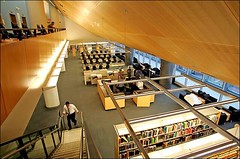Library Planning Redux
Last week, the DC Library System announced a series of public "listening sessions" about library planning. I guess that's in keeping with the general rostrums that when you're in a library you're supposed to be quiet, but I don't feel as if they are really eagerly seeking to expand structured civic engagement opportunities.
To wit, the Library System hadn't put any of the planning documents online or otherwise made them available to the public, until DC Watchdog Dorothy Brizill started asking them about it.
Yesterday's NYT has an interesting story, "New Bronx Library Meets Old Need," about the opening today of the new Bronx Library Center. This library serves an ever-changing immigrant population so its collections include a Latin and Puerto Rican Cultural Collection (in line with my suggestion at the Citizens Summit about linking libraries to local and neighborhood history, as well as the suggestion to combine City Museum functions in with a new Central Library), as well as a lot more space and more types of media, rather than just books.
From the article:
Despite its obsolescence, the old building was opening eyes right up to the end, before the shuttering on Thanksgiving weekend. Joe Hernandez, 16, an 11th grader at Walton High School, had found a table in the corner of the basement reference room to study for a chemistry test with a 16-year-old classmate, Vanessa Barrientos. "It's a good place to study because it's quiet," said Mr. Hernandez, who hopes to be an engineer someday...
"This old building, I love it here," he said. "It's a great idea to have a new building," he added, "but I hope they'll offer the same services." Not to worry. The new library, which will be open seven days a week, will have 200,000 books, periodicals and other media compared with 125,000 in the old one...
The library will also serve as a student and small-business advisory center, a literacy training hub, a meeting place, a performance space and a central library institution for the borough, said Daniel Heuberger, a principal with Dattner Architects, the lead designer of the building.
Given the Barnes & Noble model, the library will have plenty of comfortable chairs, mostly near the building's glass curtain wall. The central concourse-level reception area can be used as a gallery and is connected to a 150-seat auditorium with projection booth and theatrical-production facilities.
The second-floor areas for children offer an enclosed toddler space and a story-hour room with a puppet theater. The third floor, with its adult circulating collections, also has its own ornament: a south-facing, sunlit terrace that can be an outdoor reading room and exterior event space...
Mr. Alvarez said the old library had 321,436 visitors in 2005, and he hopes for at least three times that - a million patrons - over the next year. Although there are those who say that in the age of the Internet, libraries are obsolete, "people are using our libraries more than ever," Ms. Kent said.
 Suzanne DeChillo/The New York Times. The new fourth-floor reference area at the renovated Bronx Library Center.
Suzanne DeChillo/The New York Times. The new fourth-floor reference area at the renovated Bronx Library Center.However, I'd say it'd be good to focus somehow on reading, since one of the problems with DC as a "city of learning" is that children are increasingly visually and aurally literate but not print-word literate, and that many demographics in the city are either functionally illiterate or aliterate (meaning uninterested in reading). (I find it worrisome that DC's Library system has one of the lowest circulation rates of any major library system in the United States.)
The Library Planning documents are available online here:
a summary; the draft report; and the draft technical report.
As Dorothy Brizill wrote "If you’re planning to go to one or more of the listening sessions, please take the opportunity to read at least the draft report to see whether you agree with their plans."
The listening session schedule is:
-- Tuesday, January 17, 5:30 p.m., Washington Highlands (Ward 8), 115 Atlantic Street, SW, 645-5880;
-- Wednesday, January 25, 6:30 p.m., Woodridge (Ward 5), 1801 Hamlin Street, NE, 541-6226; -- Saturday, January 28, 1:30 p.m., Martin Luther King, Jr., Memorial Library, 901 G Street, NW, 727-0321;
-- Tuesday, January 31, 6:30 p.m., Cleveland Park (Ward 3), 3310 Connecticut Avenue, NW, 282-3080;
-- Tuesday, February 7, 6:30 p.m., Martin Luther King, Jr., Memorial Library, 901 G Street, NW, 727-0321;
-- Saturday, February 11, 12:30 p.m., Petworth (Ward 4), 4200 Kansas Avenue, NW, 541-6300;
-- Wednesday, February 15, 6:30 p.m., Georgetown (Ward 2), 3260 R Street, NW, 282-0220; --- Tuesday, February 21, 6:30 p.m., Mt. Pleasant (Ward 1), 3160 16th Street, NW, 671-0200; --- Saturday, February 25, 12:30 p.m., Northeast (Ward 6), 330 7th Street, NE, 698-3320;
-- Monday, February 27, 6:30 p.m., Francis A. Gregory (Ward 7), 3660 Alabama Avenue, SE, 645-4297.
"During the Listening Sessions citizens will discuss the Task Force recommendations and share their ideas on transforming the District’s public librariesinto a system serves their needs. The sessions will last 90 minutes and will include a review of the Task Force recommendations, a DVD presentation on libraries and a group discussion."
Index Keywords: libraries



0 Comments:
Post a Comment
<< Home